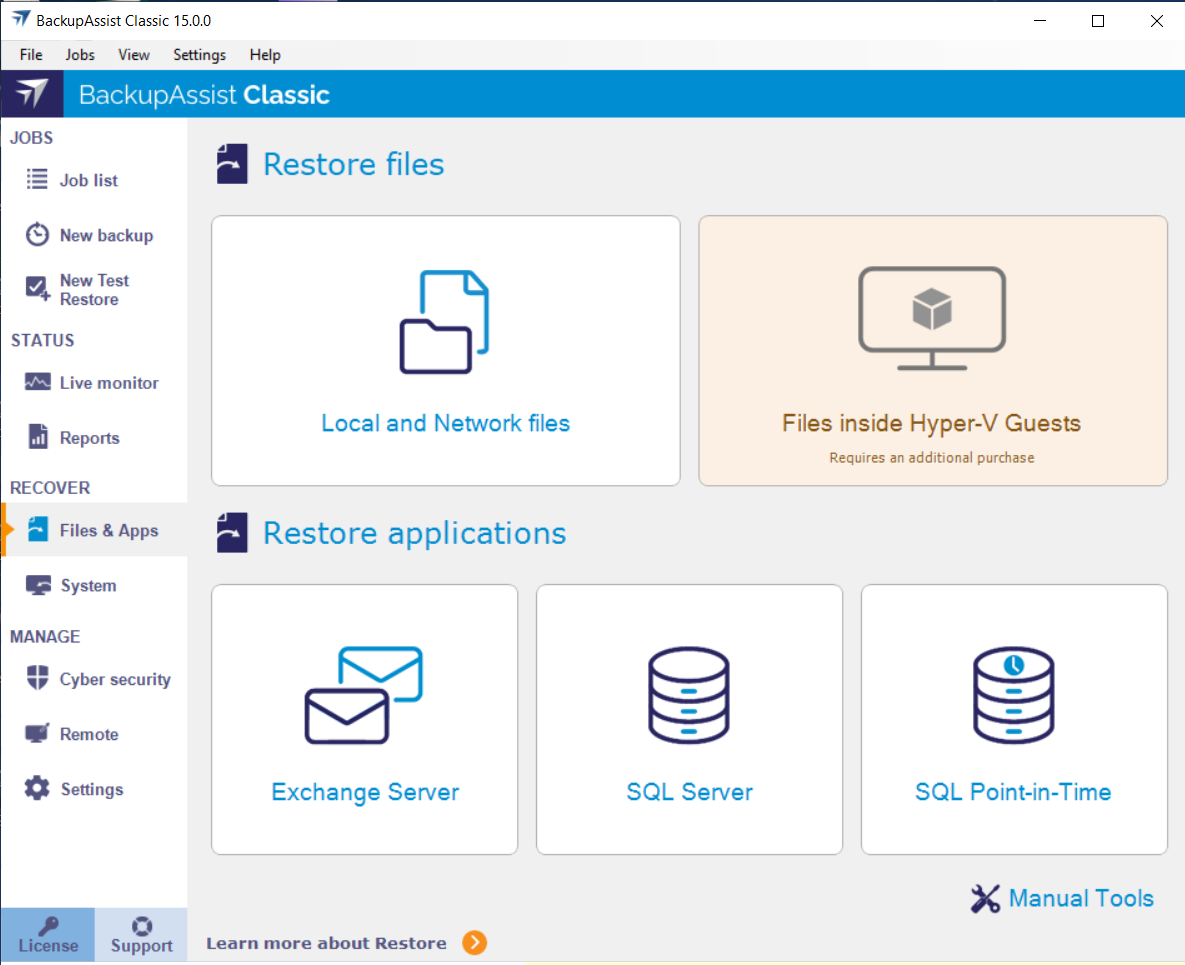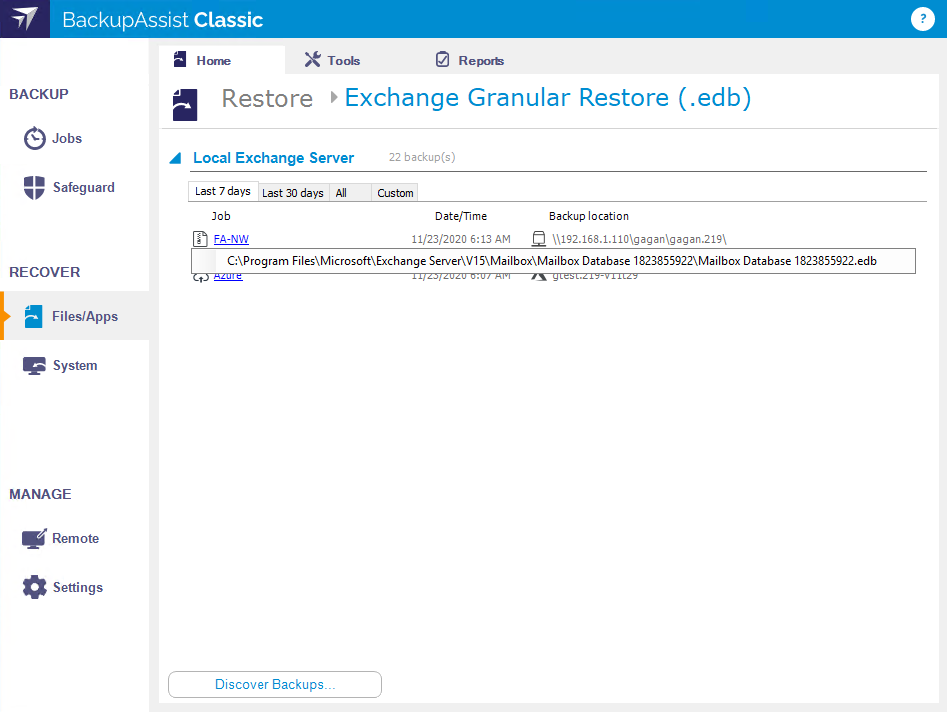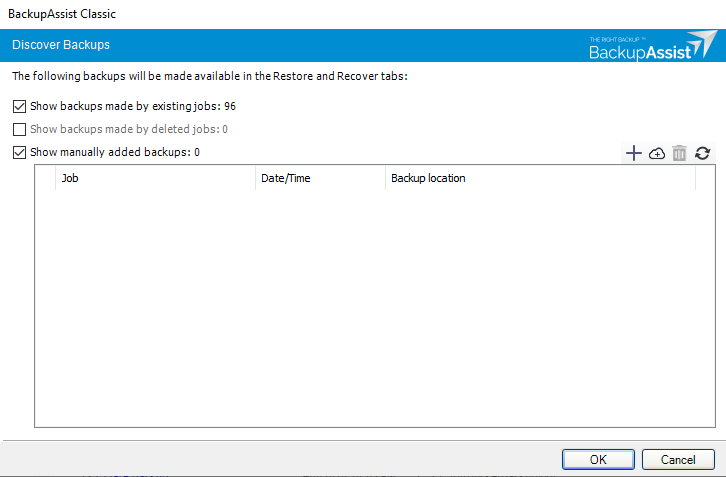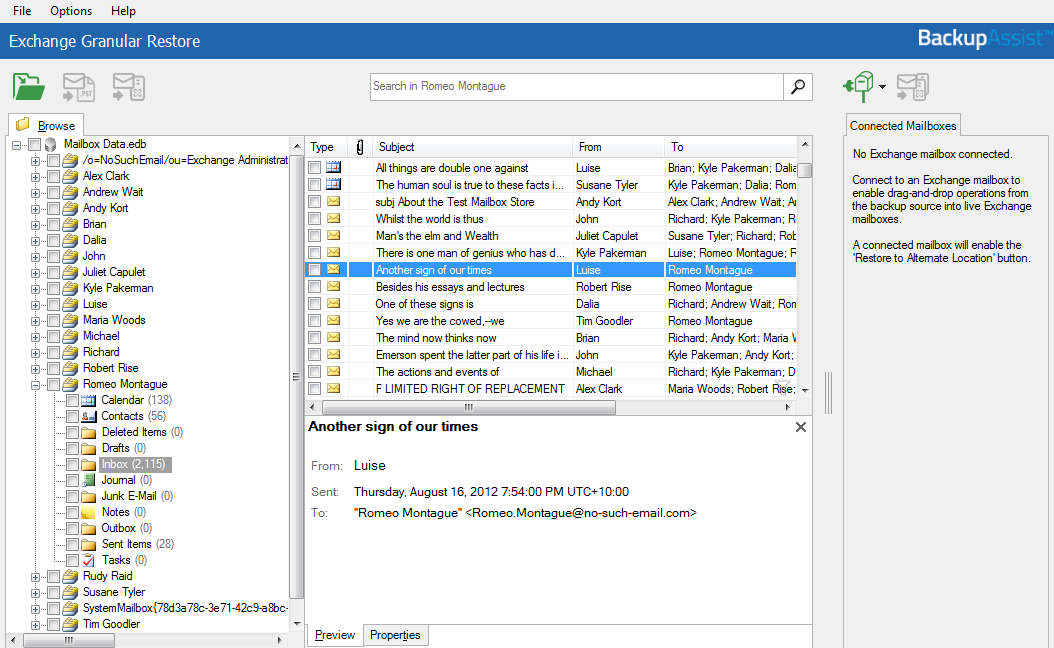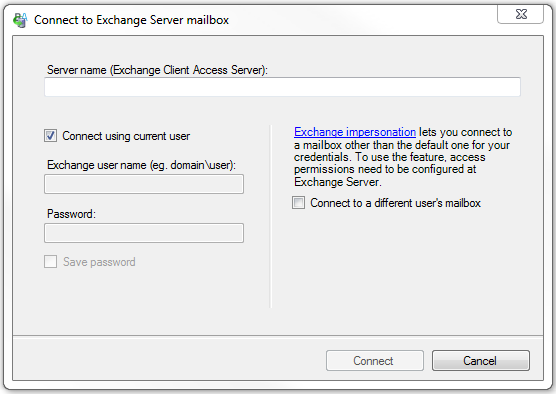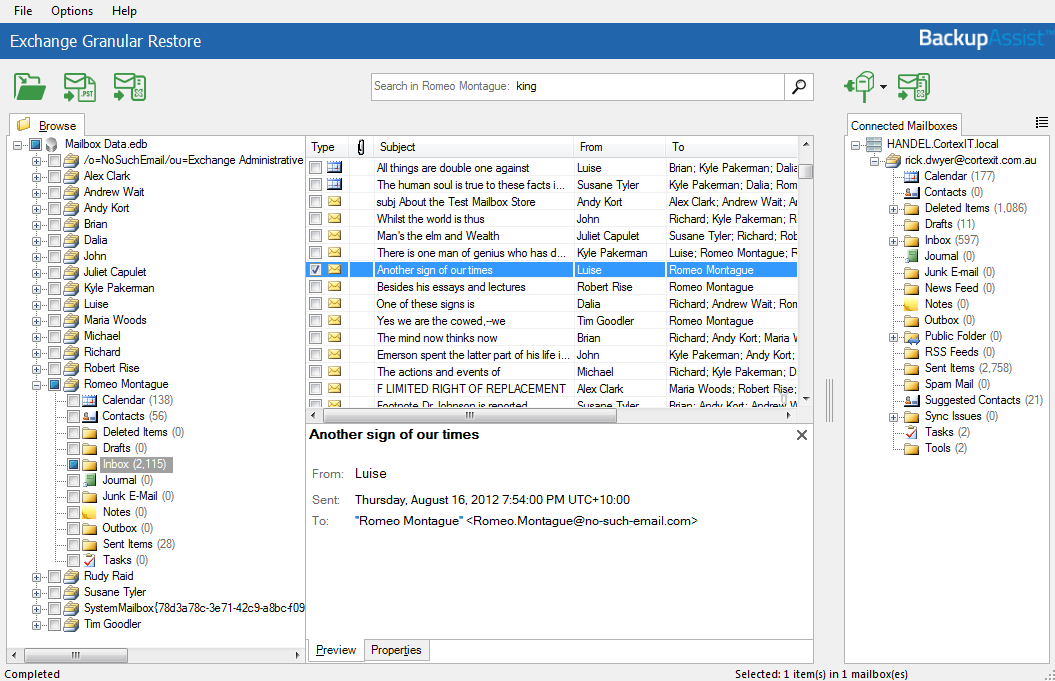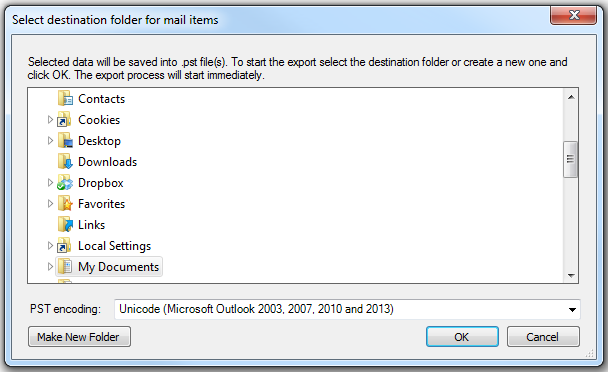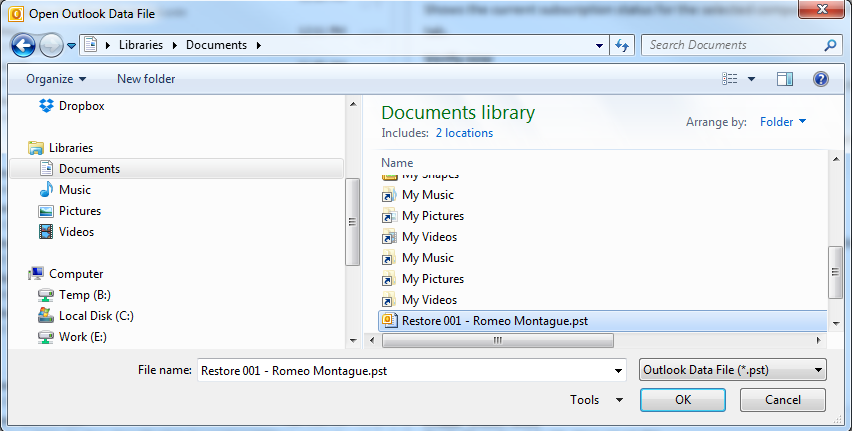This feature is no longer supported from 23 Sep 2025 - for more detail see here.
This section explains how to perform an Exchange Granular Restore using a System Protection, File Protection or File Archiving backup. Exchange Granular Restore will restore individual mail items from an Exchange Server database or PST file.
This feature requires the Exchange Granular add-on
Restoring mail items into an Exchange Server on a Hyper-V guest requires both the Exchange Granular add-on and a Hyper-V Advanced add-on license.
The Hyper-V Granular Restore tool will automatically mount the guest so that Exchange Granular Restore can restore mail items into it.
The Exchange Granular Restore tool can be opened by itself from the Tools menu. When you open the tool it will not have a backup selected, as the backup selection is part of the guided restore process that is started from the restore Menu.
However, if you open the Exchange Granular Restore console from the Tools menu, you can use it to browse for EDB (Exchange Database ) files, PST (mailbox) files or an OST (offline mailbox) files. You can then select the mail items in these mail files and restore them using the normal Exchange Granular Restore options. When you open Exchange Granular Restore from the tool's menu, it will open with a browse dialog so that you can look for the mail file.
Not all types of mail items can be restored to all types of destination folders. The following table shows the compatibility matrix of source mail item types and destination directories.
| Item type | *Mail folder | Journals | Notes | Contacts | Calendar | Tasks |
| Message | Y | Y | Y | Y | Y | Y |
| Journal | Y | Y | Y | Y | Y | Y |
| Sticky Note | Y | Y | Y | Y | Y | Y |
| Contact | N | N | N | Y | N | N |
| Calendar | N | N | N | N | Y | N |
| Task | N | N | N | N | N | Y |
* The Mail folder includes Deleted Items, Drafts, Inbox, Junk, Outbox and Sent.
If some or all of the selected items cannot be restored (using drag and drop or clicking the Restore to alternate location button) to the destination folder, then an error message will be displayed.
To restore Exchange mail items, follow these 3 steps:
Step 1 - Locate the Exchange backup
- Select the File/Apps tab
- Select Exchange Granular Restore
- Select the database
- All - shows all backups available.
- The Last 7 days and Last 30 days tabs - shows the backups within those ranges.
- Custom - allows you to select a specific date range and display backups for that period.
- If you select Show manually added backups, backups from other BackupAssist installations that were added using the + option will be available when you go back to the main restore screen.
- If you select Show backups made by deleted jobs, backups made by deleted backup jobs will be displayed and available when you go back to the main restore screen.
- If you select Show backups made by existing jobs, only backups made by the current list of local backup jobs will be shown. This is the default list you saw before using the Discover Backups option.
- Selecting the plus symbol will open a browse dialog that can be used to locate backups made by other BackupAssist installations and add them to the Discover Backups screen.
- Selecting the cloud symbol will open a dialog from where you can select and configure the cloud destination that you want to restore from. This option allows you to restore from a backup created on another machine or a deleted job.
- Selecting Delete, removes any selected backups that were added using the + option.
The Files\Apps tab has a Home page and a Tools page. The Home page is the default page and the starting point for performing a restore. The Tools page should only be used by experienced users or with the assistance of BackupAssist Technical Support.
This starts the guided restore process and will take you to the Exchange Granular restore console. There is a Learn more about Restore link at the bottom of the screen.
The Exchange Granular Restore screen displays the Exchange backups created by this installation of BackupAssist. Click on a backup’s name to show the Exchange databases in that backup, and the select the required database.
When you click on a backup, the Exchange EDB databases in that backup will appear under it. Clicking the Exchange EDB database will open the Exchange Granular Restore console. The console will open the database and allow you to view the mail items inside it.
There are tabs above each volume’s backup list that can be used to filter the list of backups shown. Using these filters will help in locating the required backup.
The display tabs available are:
Discover Backups
This option allows you to add and restore from backups created by other installations of BackupAssist and backups made by local jobs that have been deleted.When you select the Discover Backups button, the Discover Backups screen will appear.
Selecting only one of these options means only those backups will be shown when you go back to the main restore screen. Combinations of these 3 options can be selected to get the set of backups that you want.
Step 2 - Locate the mail items
The Exchange Granular Restore console has a Browse mail tree and a Search field to help locate, preview and select the mail items that you want to restore.
The Options menu
The Exchange Granular Restore console's Options menu has selections that effect the mail items shown when using the Browse and Search options to locate mail items. The Options menu should be reviewed before looking for a mail item.
Display hidden deleted items
Selecting this option will give access to previously deleted mail items. This is not mail from the delete items folder but mail items that are no longer present. The database will reload when a selection is made and the deleted items will have a flag to indicate that they are a deleted item.
- Deleted items from Exchange Server 2007 are stored in their original folders.
- Deleted items from Exchange 2010 and later are stored in the Deletions folder. These items cannot be restored to a live Exchange Server database. It is recommended that these items are exported to a PST file and then imported into the live Exchange Server.
Display time
Select Display time, from the Options menu and select Local or GMT. This applies to the date in the properties tab of a mail item. The database will reload when the format is changed.
Add Restored to exported items
When you restore individual emails or a mailbox, the word RESTORED will appear in the Subject line of every email. This is enabled by default and can be turned in using the EGR Options menu by selecting Options > Add 'RESTORED' to exported items > No.
Using Browse
You can locate a mail item by browsing through the Exchange database in the console's left pane. Browsing for the items you want to restore is ideal when you know the mail item's location.
Using Search
You can locate a mail item by using the console's Search field. Searching for the items you want to restore is ideal when you do not know the mail item's location. Clicking in the Search box opens a drop-down dialog that can be used to enter search criteria.
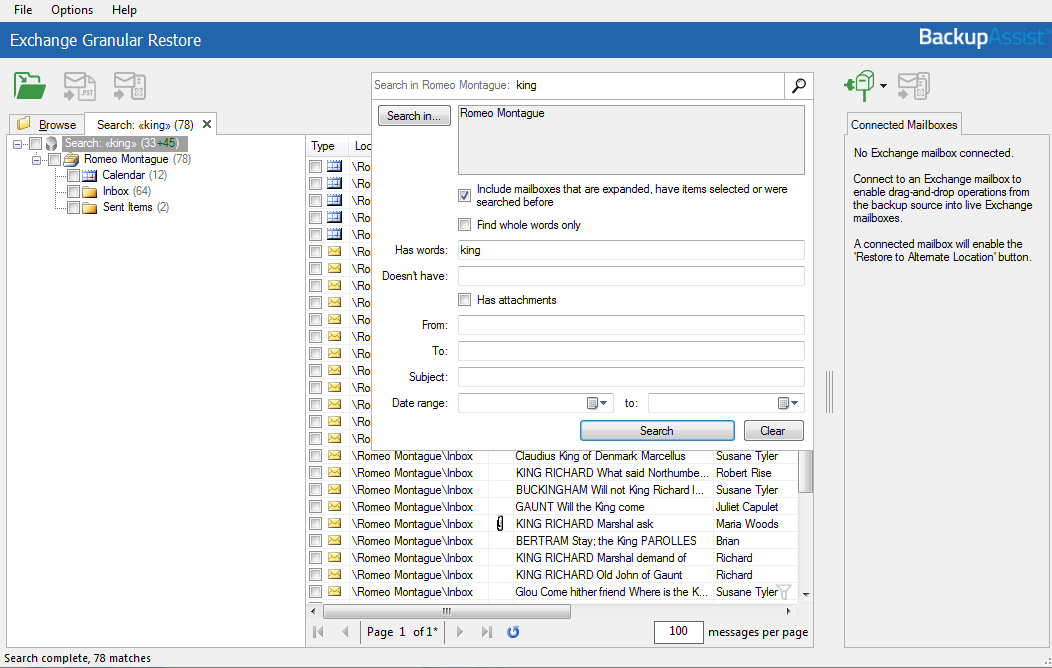
The Search field will search the entire database by default. If you select a specific mailbox, only that mailbox will be searched and the mailbox name will appear in the Search field.
To perform a search:
- Enter the search word into the Search field.
- Use the drop-down box to enter any additional search criteria. This step is optional.
- Has words, searches for mail items that have words or phrases entered into the field.
- Doesn't have, searches for items that do not have words or phrases entered into the field.
- Has attachments, will search for items with attachments.
- From, will search for keywords in the From: field.
- To, will search for keywords in the To: field.
- Subject, will search for keywords in the Subject: field.
- Date range, can be used to set a specific date range. A beginning and end dates must be set.
- Select the search icon next to the Search field.
- A new tab will open containing the mailboxes and items that match your search criteria.
The following search options are available:
If a search does not match any items, review your search parameters and run another search.
Once you have located the mail items that you want to restore, select them using the tick box. Once you have selected an item to restore, the restore type icons in the menu will become active.
Step 3 - Perform the restore
Once you have located the required mail items, there are three ways they can be restored using Exchange Granular Restore: Restore to original location, Restore to alternate location and Export to PST.
Note: When you restore individual emails or a mailbox, RESTORED will appear in the Subject line of each email. This is enabled by default and can be turned off by selecting Options > Add 'RESTORED' to exported item > No.
Option : Restore to original location
This option will restore the selected mail items back into their respective mailboxes on the original Exchange Server.
- Select the Restore to original location button.
- If no Exchange Server was detected, fill in the Server name field and click Reconnect.
- Select Restore to begin the restore process.
- The restore can be canceled by clicking the Cancel restore button.
- The progress window can be reopened by clicking Progress bar on the status panel.
- Selected items will be copied into their original locations on the live Exchange Server. If selected items cannot be matched to a destination mailbox, they will not be restored.
- The destination Exchange Server is detected automatically using the current Active Directory domain. If necessary, you can change the server name and attempt a reconnect.
A Restore to original location window will open. The domain name of the server running Exchange will be automatically detected if you are on the same domain.
It is possible to restore data to someone else’s mailbox using Exchange Impersonation. To do this, the current user credentials must have Exchange Impersonation access to the destination mailbox.
To learn more, see Exchange Impersonation
A progress window will be displayed during the restore. The window shows the number of folders, messages and errors. You can enable and disable the progress window in the Options menu.
Restore considerations
Option : Restore to alternate location
This option will restore the emails and mail items from the offline backup to a live Exchange database that is different to the one they were backed up from.
- Select the Connect to Exchange Mailbox button.
- Server name - Domain name Exchange Server or IP address
- Mailbox user name - This will identify, authenticate and open the applicable mailbox.
- Password- The password for the applicable mailbox.
- Restore mail items to an alternate location
- The hierarchy of the data being dragged will be recreated inside the destination folder.
- You can create a new folder in the live mailbox by right clicking the mailbox or a folder. Note, you cannot delete or rename a folder once it has been created.
- The data hierarchy will be restored automatically.
- The root of hierarchy is the closest common parent item.
The Connect to Exchange Mailbox button opens the connection dialog. This is used to provide the Exchange Server name and the authentication details for a specific mailbox on that server. This process can be repeated for additional mailboxes.
The Restore to alternate location button will become active when a connection has been made.
Enter the following details into the connection dialog box:
If Use current Windows credentials is selected, the existing user’s Windows password will be used.
If Exchange Impersonation is selected, enter the SMTP address of the mailbox that you want to connect to. Exchange impersonation must also be configured on the Exchange Server.
Once the connection has been made, the mailbox you have authenticated to will appear as a mailbox tree in a new pane called Connected Mailboxes. You can open a preview pane for the destination mailbox tree by selecting the Show item list and preview icon (CTL+R), to the right of the Connected Mailboxes pane.
There are two ways to restore mail items to the alternate location. You can drag and drop the files from the backup to the restore destination, or select the mail items and then use the Restore to alternate location button.
Drag and drop mail items from the backup, into the live Exchange mailbox that you connected to.
Click the check-box next to items that you want to restore and select the Restore to alternate location button. A dialog box will open and allow you to select a destination folder on one of the connected mailboxes. Make your destination selection and select OK to begin the restore
Option : Export to PST
Export to PST will save your selected data in a PST file, which can be opened by outlook to access the mail items.
- Confirm the Personal Storage Table (PST) format
- For ANSI PST files, the size limit is 1 GB.
- For Unicode PST files, the size limit is 10 GB.
- A maximum of 15,000 messages can be restored into the PST file.
- When this limit is reached, an additional PST file is created.
- Select the , Export to PST button
- Select the destination.
- Open the exported mail items in Outlook.
- Restore the exported items to the Exchange Server.
- Open the PST file that contains the exported mail items.
- Open the mailbox that you need to import the data into.
- Drag-and-drop the item them back into their original folders. They will be automatically synchronized with the live Exchange Server database.
You can choose Unicode or ANSI encoding for the PST output file using the Options menu.
The Exchange Granular Restore console exports each mailbox into a separate .pst file named: “Restore NNN <Mailbox Name>[ VVV]. pst”, where NNN is the current recovery session identifier and VVV is the volume number, in case the PST file has to be written in more than one volume.
With large exports, there can be more than one PST file. Additional files are created automatically when the file size limit is reached. The size limit depends on the output file encoding.
This button will become active once the mail items have been selected.
You will be asked to select a folder or create a new folder. After selecting the new or existing folder, the export will begin.
You will be shown a progress window during the export. The window shows the number of saved mailboxes, folders and messages. The export can be canceled by clicking the Stop Export button. If you close the progress window, it can be opened again by clicking the status panel’s progress bar.
The items selected (even if you only selected one item) will be exported as a PST file.
Items extracted from an offline Exchange mail store can be restored to a live server.
Make sure you have Microsoft Outlook and access to the mailbox that you want to restore the mail items into.
Perform the restore as follows:
